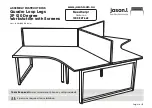
6
CAUTION
y
The top of the plates is very hot and can cause burns.
y
875001 / 875004 hot and cold plates with glassware top :
-
Tempered glassware can be scratched by some cast iron dishes.
Lay the dishes onto the glassware and do not slide them
horizontally.
-
Caution: do not use the devices if the glassware is cracked.
y
875005 / 875006 / 875007 / 875030 bains-marie :
-
Never use the bain-marie if the tank is empty. If it is used without any water, it will cause the heating element to be
deformed and damaged.
y
This equipment is not intended for use by individuals (including children) with reduced physical, mental or sensory capacities,
or by individuals lacking the necessary experience or knowledge, unless they have received supervision or prior instructions
relating to the use of the equipment by an individual responsible for their safety. Children should be supervised in order to
ensure that they do not play with the equipment.
SERVICING
y
Prior to servicing, unplug the electric devices and allow them to cool before cleaning.
y
The electric devices must not be cleaned with water spray
. The bain-marie tank is machine-washable after the electric
heating element located below the tank has been removed. The heating element must not be soaked.
y
General information on stainless steel : The term “stainless steel” can cause some confusion. It is steel which “resists” to
corrosion in certain conditions.
Any type of stainless steel can be corroded:
-
austenitic, e.g. “stainless steel 304” also called 18/10.
-
ferritic, e.g. “F17” or “F18TNb”.
Resistance to corrosion of stainless steel results from the existence of a passive layer of chromium oxide which is renewed
spontaneously when in contact with the air. Any phenomenon interfering with the creation of this layer is likely to cause
corrosion.
This is why stainless steel surfaces must be regularly rid of miscellaneous contamination which may damage the level of
resistance of the passive layer, and also ensure the maintenance steps are observed. (Preparation to cleaning / cleaning /
rinsing / disinfection / rinsing / drying).
Regular maintenance with extended rinsing with water is the best method to renew and maintain the passive layer.
Each of the steps linked with maintenance presents risks of damaging the passive layer: using hard water / overdosing
detergents / using chlorine-based detergents / food residue on the products / insufficient rinsing…..
Whenever corrosion appears, the element or step having led to it must be identified.
y
Advice :
-
maintain stainless steel surfaces clean and dry. Ensure there is a sufficient flow of air.
-
clean daily to remove scale, grease and any food residue. Corrosion can form under these layers by lack of air inlet.
-
daily cleaning can be performed with a damp cloth. If necessary :
* use soapy water, cleaning products with low chloride content, javel-free detergents, window degreasers.
* remove hard stains with a non metallic brush (plastic material, natural bristles or stainless steel wool).
-
do not scratch the surfaces with metals other than stainless steel, and more particularly, never use iron brushes.
-
remove fresh rust stains with soft abrasive agents or fine emery cloth.
-
for larger stains, use hot oxalic acid with a 2-3% concentration. If necessary, apply a treatment with nitric acid concentrated
at 10%.
After treatment, wash thoroughly with water and wipe.
The use of acid is reserved to skilled persons and complying with regulations.
y
Product to ban :
-
Javel water and chlorine based products
-
hydrochloric acid
-
iron oxide abrasive powders.
y
Aluminium top : wash-up liquid.
y
Tempered glassware : product suitable for glassware or glass-ceramic plates. Do not use abrasive sponges or products. Try
not to use aggressive cleaning products, such as those suitable for ovens or stain removers.
y
Eutectic plate and plate support : do not use products likely to damage plastic (ethyl alcohol, pure bleach, or wine-, vinegar-,
spirit-, nitric, sulphuric, hydrochloric acid-based products).
MAINTENANCE
y
H05RNF 3X1mm2 type feeder cable. In order to change a damaged cable or for any maintenance operation, contact an
approved customer service provider.
This equipment carries the recycling symbol in accordance with Directives 2002/95/CE and 2002/96/CE relating to Waste
Electrical or Electronic Equipment (DEEE or
WEEE) At the end of its working life the equipment should be recycled
in accordance with the regulations that are in force in the country of its installation.


































